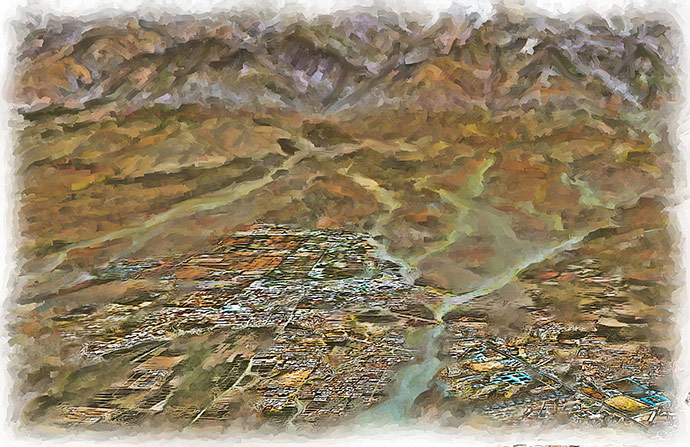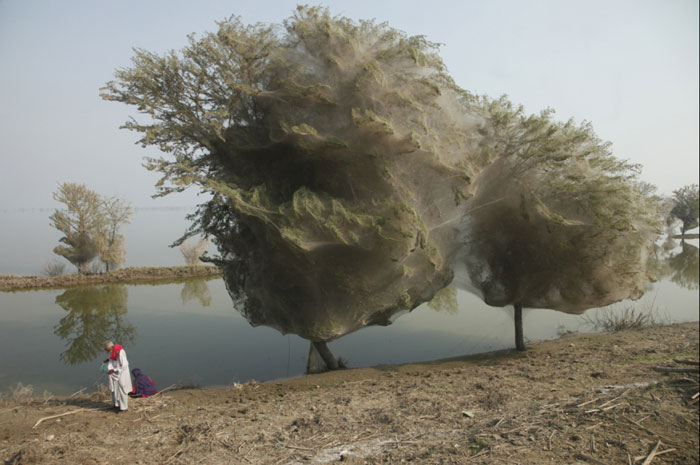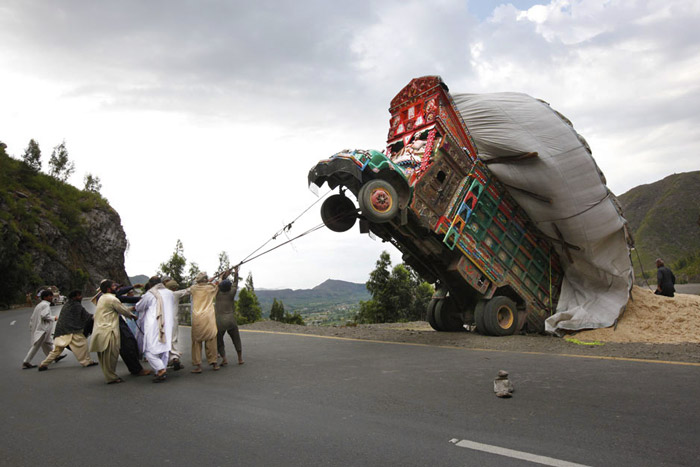Hole in the Clouds
Dec 10, 2009

Two girls who have recently immigrated to the United States, one from China and the other from Pakistan, have learned enough English and reading in Michele Manno's sixth-grade class to enjoy storybooks. Ms. Manno observes that both girls are good kids, eager to learn and interested in school, but one of them studies hard and the other "wants it spoon fed." They live and attend school in Queens, New York.
Queens
Pakistan
New York
sixth grade
Michele Manno
middle school
China
(Image credit: Michele Manno)
Aug 15, 2009

If you believe what you read in Earth Imaging Journal, which you shouldn't, there's an 86.6% chance that bin Laden has been living here in Parachinar, Pakistan, ever since he was last seen by Western intelligence agents--not seen, actually, but heard from, on VHF radio--in December 2001. The mountain ridge at the top of this picture is the border between Pakistan's Kurram tribal region and Afghanistan's Tora Bora district,
A couple of UCLA professors wrote recently in Earth Imaging Journal that they had used high-resolution satellite imagery, similar to the imagery we are familiar with in Google Earth, to identify the three buildings in Parachinar most likely to be inhabited by bin Laden and his close associates. The professors looked for defensible structures of appropriate size that are on the electric grid or served by generators, with trees and shrubbery to complicate surveilance from the air. One of the three likely compounds turns out to be the local prison--and why not? The tradition of fugitives seeking refuge in prisons is long and illustrious.
But the good professors claim to have no actual evidence concerning his whereabouts; it's all an exercise in geospatial modeling, utilizing distance-decay theory and island biogeography. Ivory tower stuff.
The only thing is: I just googled Parachinar, and for the last couple of weeks now, the city has been bombed by the Pakistani Air Force, presumably at our direction. They say they're targeting Taliban, not al-Qaeda--whatever they're doing, please let it not be based on distance-decay theory and calculations at UCLA of an 86.6% slam dunk.
Perhaps you're like me and don't remember exactly what went down back in December 2001, when we invaded Afghanistan and announced that we'd pinned down Osama bin Laden in his cave in Tora Bora. We knew all about the caves there because a generation ago, we'd helped some anti-Soviet Afghan warlords forttify them and build a complex of underground bunkers.
We asked Afghan army troops to go in there and kill all the bad guys, backed up by our air support, Special Forces, and CIA operatives. As soon as the Afghan forces arrived in the area, they announced that the bad guys wanted a temporary cease-fire, so they could gather their weapons and surrender. It is said that our response was "What the hell? Go on in and get 'em." At that point, the Afghan soldiers turned their weapons on the U.S. "advisers," and it took 12 hours before they agreed to resume the mission. Evern after the end of the "cease-fire," it is believed that some of the Afghan soldiers staged a diversionary action to further delay and weaken the attack. Several hundred Taliban were eventually killed or rounded up in the caves of Tora Bora, but no major weapons caches or "training camps" were found.
It is possible that bin Laden escaped into Pakistan during the fake cease-fire, hiking through the December ice and snow, up and over a 14,000-foot mountain pass. It's also possible that he had already escaped by then, or that he'd never been there in the first place.
U.S. General Tommy Franks blamed the Pakistanis for not telling us that their border wasn't very secure near Tora Bora. Where in the world is Tommy Franks these days?
Pakistan
Tora Bora
Parachinar
Kurram
Earth Imaging Journal
al-Qaeda
Afghanistan
Tommy Franks
Osama bin Laden
Apr 6, 2011
 Last summer, when floodwaters swamped one-fifth of all the land in Pakistan, spiders were among the creatures struggling to escape the rising waters. Spiders moved up into the trees, while the water on the ground stayed high for so long that the new eight-legged tree-dwellers had plenty of time to spin web upon web among the branches.
Last summer, when floodwaters swamped one-fifth of all the land in Pakistan, spiders were among the creatures struggling to escape the rising waters. Spiders moved up into the trees, while the water on the ground stayed high for so long that the new eight-legged tree-dwellers had plenty of time to spin web upon web among the branches.
Today, many of the trees of Pakistan are tangled up in spiderwebs. And it has been reported that many of the mosquitoes of Pakistan have been snagged in the webs, resulting in a much smaller than anticipated post-flood mosquito problem.
Pakistan
animals
(h/t: Cathy Goldwater)
flood
spiders
insects
(Image credit: National Geographic)
Aug 26, 2011
 A fruit picker falls asleep on the tangerines in Lahore, Pakistan.
A fruit picker falls asleep on the tangerines in Lahore, Pakistan.
For more images of people settling down for naps "surrounded by stuff" from all over the world, look here.
Pakistan
sleep
tangerines
Lahore
(h/t: JJ Stein)
Jan 9, 2013
 There was evidently just a little too much weight in the back for this truck to navigate the winding mountain road through the Malakand district north of Islamabad in Pakistan. The men tugging on ropes could not right the vehicle, but they were able to keep it from completely flipping over while other men worked to lighten the load, which was wheat straw intended for use as animal feed.
There was evidently just a little too much weight in the back for this truck to navigate the winding mountain road through the Malakand district north of Islamabad in Pakistan. The men tugging on ropes could not right the vehicle, but they were able to keep it from completely flipping over while other men worked to lighten the load, which was wheat straw intended for use as animal feed.
Pakistan
work
truck
rope
men
accident
spill
mishap
(Image credit: Mian Khursheed for Reuters)




